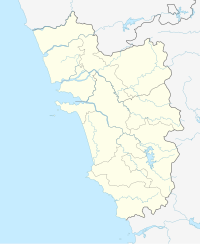Corjuem Fort
| Corjuem Fort | |
|---|---|
Forte da Assunção de Corjuem | |
| Part ofGoa | |
| Bardez,Goa | |
| Coordinates | 15°35′48″N73°53′34″E/ 15.5968°N 73.8928°E |
| Type | Fortress battery |
| Site information | |
| Controlled by | Portuguese India(1705–1961) India(1961–present) |
| Open to the public | Yes |
| Condition | Partial Ruin |
| Site history | |
| Built | 1705 |
| Built by | Caetano de Melo e Castro |
| In use | Abandoned in 1894 |
| Demolished | no |

Fort Assunção[1]orCorjuem Fortis a fortress situated 4 kilometres (2.5 mi) from the village ofAldonaon theriver islandof Corjuem,Goa.It was a military fortress for the defense ofPortuguese India.It is smaller than the other forts in Goa, but it gives a good view of the surrounding river and land. It is a protected monument under the Goa, Daman and Diu ancient monuments and archaeological sites and remains act.[2]
Corjuem Fort is 12 kilometres (7.5 mi) fromPanjim.
Location
[edit]The Fort of Corjuem (Portuguese:Forte de Corjuem) is situated on anislandwith the same name inBardez,to the east of the village ofAldona,from which it is separated by theMapuçá River(a tributary of theMandovi). It is one of the only two inland forts that are surviving that are made of pitted laterite.
History
[edit]The original occupiers of the island around the fort were theBammonsofSancoale,but it was raided by Marathas (in the late 1600s) who later transferred control to Sawant-Bhonsle of Sawantwadi. Under the Portuguese Viceroy Caetano de Mello e Castro, the control of the island came back underPortuguese India's administration.[3][4]This fort built in 1705, by the Portuguese, as a defense againstMaratha aggression,and was subsequently rebuilt and reinforced by them to boost up defenses alongPanjim. In the eighteenth century, this fort successfully protected the Portuguese from the Bhonsles and the Ranes, who were camped just beyond theMandovi River.
In the early 1800s, the fort was used as a Military School and had in its defenses a battery of four guns. The fortress defended the town ofCorjuemand also has a chapel under the parochial church of Aldona. The fort fell into disuse after the success ofNovas Conquistas,as it had lost its purpose as a border defense.[5]
Incidents
[edit]The fort also has an interesting incident in which an ambitious Portuguese woman namedUrsula e Lancastre,who determined to see the man's world, dressed as a male and took up navigation and military roles. She landed up at Corjuem as a soldier and many years later, voluntarily revealed her gender as she wished to marry a man.[6]
Santuário de Santo António de Lisboa
[edit]There is a Shrine dedicated toSt. Anthonywithin the walls of the fort, at its entrance. It is under the ownership of the Parish of Aldona and is regularly patronized and renovated.
References
[edit]- ^Joaquim Pedro Celestino Soares:Bosquejo das possessoes portuguezas no OrienteImprensa nacional, 1851
- ^Fernandes, Joaquim (Aug 19, 2014)."Goa government to restore Corjuem fort".Times of India.Retrieved21 August2016.
- ^pt:Caetano de Melo e Castro,Retrieved 10 May 2012[circular reference]
- ^da Fonseca, José Nicolau (January 1878).Historical and Archaeological Sketch of the City of Goa.Thacker & Co. p. 85.
- ^da Fonseca, José Nicolau (January 1878).Historical and Archaeological Sketch of the City of Goa.Thacker & Co. p. 86.
- ^Bryn Thomas, Douglas Streatfeild-James (Feb 1998).Lonely Planet: Goa.Lonely Planet. p. 285.ISBN0864424884.
15°35′48″N73°53′34″E/ 15.59678°N 73.89281°E
- ^"Corjuem fort to be developed as heritage touristic destination".timesofindia.Oct 2018.

